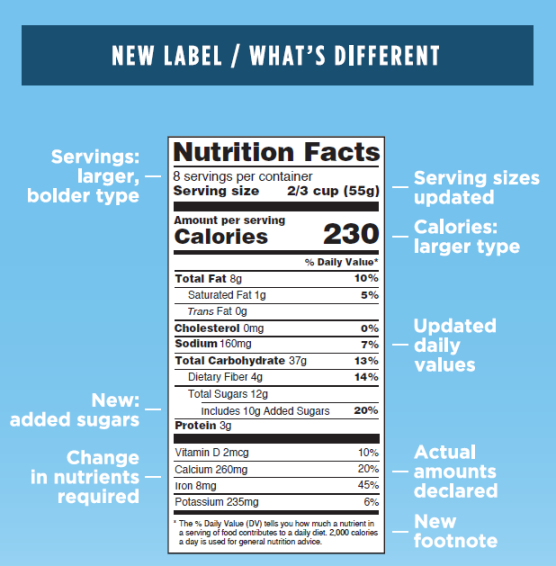New Nutrition Facts Panel Includes Added Sugars, Updated Serving Sizes
Manufacturers have up to two years to comply with the new label for food and beverage packaging.
Image provided by FDA.

The new Nutrition Facts label for packaged foods and beverages has arrived. Major changes to the label, which has largely remained the same since its creation in 1994, include a new line for “added sugar,” a larger type for calorie content, and a new system for listing serving sizes.
First Lady Michelle Obama announced the final rules for the label this morning, more than two years after FDA announced it would be updating the label to better reflect the eating habits of most Americans. Food manufacturers have until July 26, 2018 to begin using the new label on food and beverage packaging, although companies with less than $10 million in annual food sales have an additional year to comply.
“This is going to make a real difference in providing families across the country the information they need to make healthy choices,” the First Lady said in a statement.
Added Sugars
One of the most notable additions to the label is new line for “added sugars,” which will be located just below a “total sugars” line. Previously, the label featured only a listing of “sugars,” which included a combination of both added and naturally occurring sugar. But FDA believes highlighting the amount of sugar added during the production process may help Americans cut down on excess discretionary calories they might not have been aware of.
Given the amount of added sugars in food products from both the healthy and non-healthy ends of the market, the “added sugars” line was one of the most controversial proposed changes to the new Nutrition Facts label throughout the review process.
In addition to displaying the amount of added sugars per serving, the new labels will also include a Percent Daily Value figure for added sugar, calculated based on guidelines that recommend people consume no more than 10% of daily calories from added sugars.
“Scientific data shows that it is difficult to meet nutrient needs while staying within calorie limits if you consume more than 10% of your total daily calories from added sugar, and this is consistent with the 2015–2020 Dietary Guidelines for America,” FDA said in its announcement.
Serving Size
The listed serving size for many products will also have to be updated on the Nutrition Facts labels, due to a new system for determining serving sizes based on what consumers realistically consume. For instance, a single serving of ice cream will now be 2/3 cup, rather than ½ cup, and a single serving of soda will rise to 12 oz, rather than 8 oz. This is designed to reflect the fact that Americans are eating more in a single sitting than they were 20 years ago, says FDA.
Package size also comes into the equation. Package sizes that are typically consumed in one sitting will be labeled as a single serving, even if the product technically contains more than one serving. A 20-oz soda, for example, will be considered a single serving because that’s how it’s typically consumed, even though a single serving of soda is otherwise considered to be 12 oz.
And for larger products that could be consumed in one or multiple sittings, such as a pint of ice cream, manufacturers will be required to provide “dual column” labels that calculate the amount of nutrients and calories based on both a per-serving and a per-package basis.
“Our understanding of a ‘serving size’ has changed over the years,” said Lori Zanini, spokesperson for the Academy of Nutrition and Dietetics, who applauded the new Nutrition Facts panel. “The new panel now lists serving size as what is typically eaten in one sitting. This new format will help by easing or even eliminating the need to multiply several servings and daily value percentages to know how much has been consumed.”
New Design
At first glance, perhaps the most obvious change to the label is its new design, which includes a bigger and bolder type for “calories,” “servings per container,” and the “serving size” declaration. Additionally, Nutrition Facts labels must include the actual amount of nutrients such as vitamin D, calcium, iron, and potassium, in addition to the Percent Daily Value.
Other changes to the label include:
· Vitamin D and potassium now need to be listed on the label, but it’s no longer required that vitamins A and C be listed. This is because FDA finds many Americans to be vitamin D and potassium deficient, while deficiencies in vitamins A and C are uncommon. Calcium and iron listings are still required.
· A listing of “calories from fat” is no longer required because “research shows the type of fat is more important than the amount,” according to FDA. Listings for “total fat,” “saturated fat,” and “trans fat” are still required.
· Daily Values for several nutrients, including sodium, dietary fiber, and vitamin D, will be updated based on the latest dietary guidelines.
· The footnote explaining what Percent Daily Value means have been revised. It will now read: “The % Daily Value tells you how much a nutrient in a serving of food contributes to a daily diet. 2,000 calories a day is used for general nutrition advice.”
FDA’s full announcement and description of the changes to the Nutrition Facts label can be found here.
Read more:
Five Biggest Struggles with FDA’s New Nutrition Label (Slideshow)
All Eyes on FDA as Comment Period Closes for Use of the Term “Natural”
Senator Criticizes “Loophole” in Self-Affirmed GRAS System
Michael Crane
Associate Editor
Nutritional Outlook Magazine
michael.crane@ubm.com
Prinova acquires Aplinova to further increase its footprint in Latin America
April 7th 2025Prinova has recently announced the acquisition of Brazilian ingredients distributor Aplinova, which is a provider of specialty ingredients for a range of market segments that include food, beverage, supplements, and personal care.










